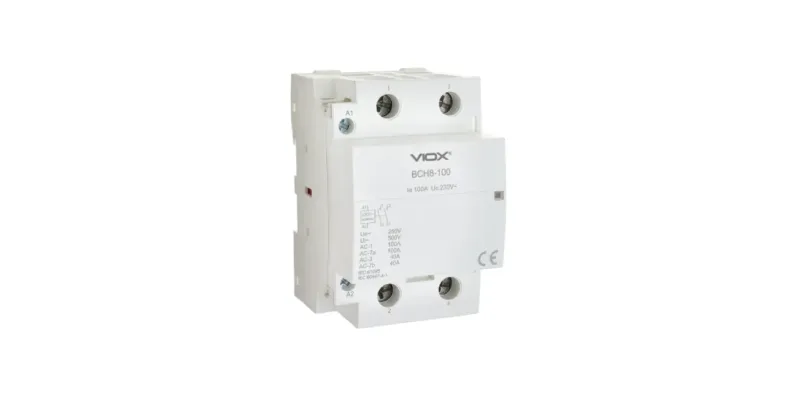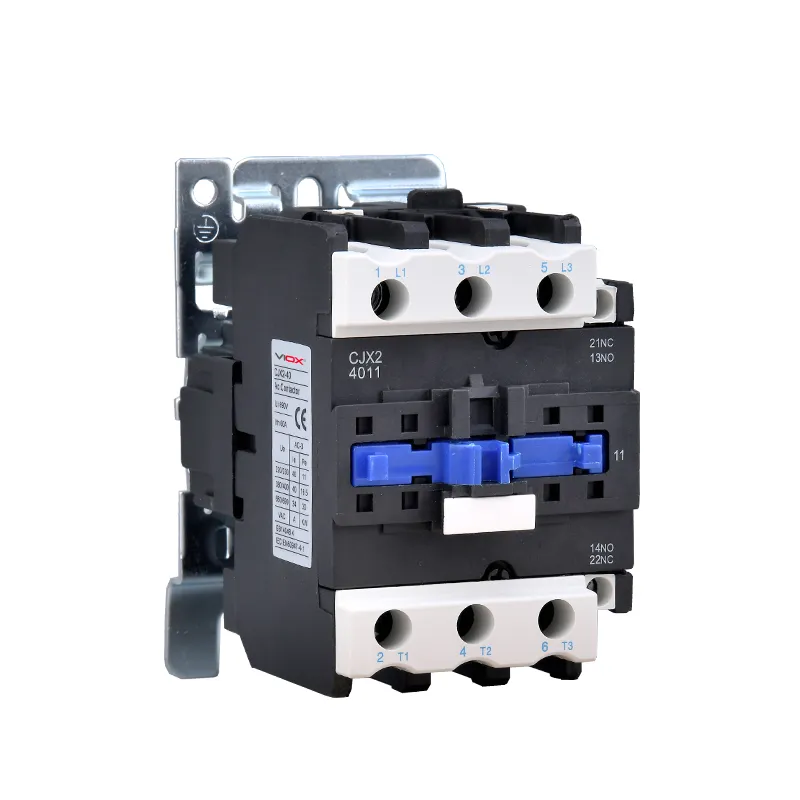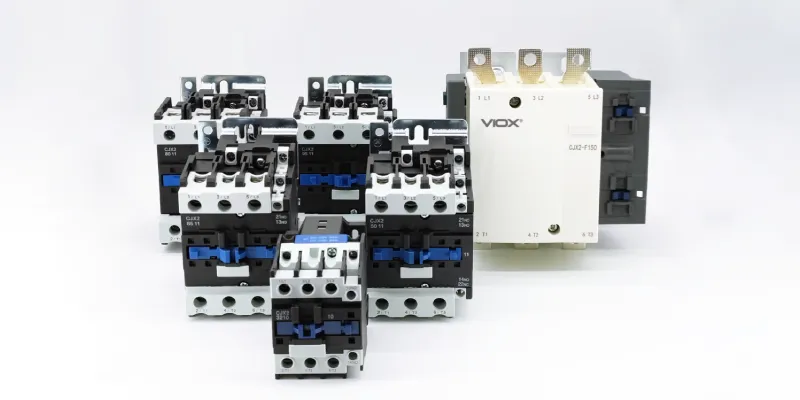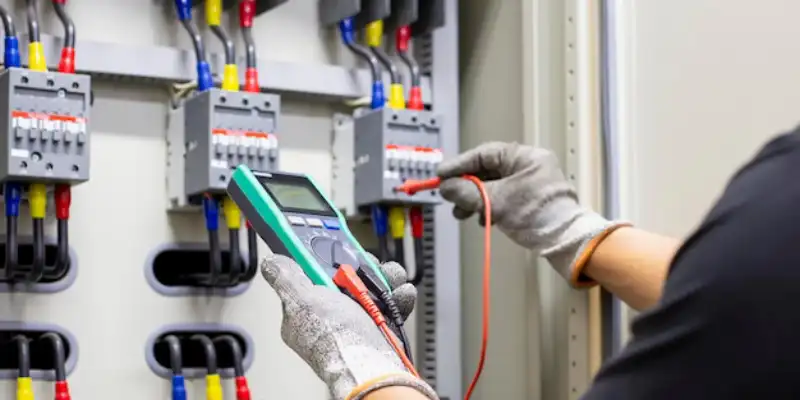Resposta Rápida: A principal diferença entre um contator modular e um contator tradicional (contator normal) é o seu projeto de montagem e configuração. Os contatores modulares são projetados para Trilho DIN Montagem em painéis elétricos com larguras modulares padronizadas, enquanto os contatores tradicionais (normais) normalmente utilizam configurações de montagem por parafuso ou em painel. Os contatores modulares oferecem instalação com economia de espaço, manutenção mais fácil e dimensionamento padronizado, tornando-os ideais para projetos modernos de painéis elétricos.
O que é um contactor modular?
Um contactor modular é um dispositivo compacto de comutação eletromagnética projetado especificamente para sistemas de montagem em trilho DIN. Esses contatores apresentam larguras modulares padronizadas (normalmente medidas em incrementos de 17,5 mm) e são projetados para se encaixar perfeitamente em painéis de distribuição elétrica modernos, juntamente com outros dispositivos modulares, como disjuntores e relés.
Principais características dos contatores modulares:
- Sistema de montagem em trilho DIN para instalação sem ferramentas
- Larguras modulares padronizadas (1, 2, 3 ou 4 módulos de largura)
- Design vertical compacto otimizando o espaço do painel
- Terminais acessíveis pela frente para fácil fiação e manutenção
- Contatos auxiliares integrados na maioria dos modelos
O que é um contator tradicional (contator normal)?
Um contator tradicional (também chamado de normal ou convencional contator) é um dispositivo de comutação eletromagnética tradicional que utiliza configurações de montagem por parafuso ou em painel. Esses contatores são o padrão da indústria há décadas e são projetados para montagem direta em painéis elétricos, centros de controle de motores ou placas de montagem.
Principais características dos contatores tradicionais (contatores normais):
- Montagem por parafuso ou porca para painéis ou placas de montagem
- Maior pegada física com orientação horizontal
- Projeto de bloco de terminais tradicional com terminais de parafuso
- Blocos de contato auxiliares separados (geralmente opcional)
- Classificações de corrente mais altas disponíveis (até 1000A+)
Comparação abrangente: contatores modulares vs. tradicionais (contatores normais)
| Recurso | Contator Modular | Contator Tradicional (Contator Normal) |
|---|---|---|
| Método de montagem | Clipe para trilho DIN | Montagem por parafuso/porca |
| Espaço do Painel | Compacto (largura de 17,5-70 mm) | Maior pegada (varia) |
| Tempo de instalação | 30-60 segundos | 5-15 minutos |
| Correntes Nominais | 5-125A típico | 5-1000A+ disponível |
| Gama de tensões | 24 V-690 V CA/CC | 24 V-1000 V CA/CC |
| Contactos auxiliares | Geralmente integrado | Complemento frequentemente separado |
| Gerenciamento De Arame | Organizado, compacto | Fios tradicionais |
| Acesso de manutenção | Acessível pela frente | Pode exigir a remoção do painel |
| Custo por unidade | Moderado a alto | Baixo a moderado |
| Padronização | Alto (padrões IEC) | Variável por fabricante |
Aplicações e casos de utilização
Quando usar contatores modulares
Aplicações ideais:
- Sistemas de automatização de edifícios exigindo acesso frequente ao painel
- Painéis de controle do motor com restrições de espaço
- Sistemas de controlo da iluminação em edifícios comerciais
- Painéis de controlo HVAC com múltiplos requisitos de comutação
- Armários de controle de máquinas exigindo componentes padronizados
Casos de uso específicos:
- Estações de controle de bombas com espaço limitado no painel
- Contatores de iluminação LED em salas elétricas
- Controles de motores de transportadores na fabricação
- Controles de unidades de tratamento de ar em edifícios comerciais
Quando usar contatores tradicionais (contatores normais)
Aplicações ideais:
- Controle de motor industrial pesado exigindo altas classificações de corrente
- Substituições de sistemas legados mantendo as configurações existentes
- Projetos sensíveis a custos onde o espaço não é limitado
- Aplicações de alta potência classificações acima de 125A
- Instalações ao ar livre exigindo gabinetes robustos
Casos de uso específicos:
- Grandes motores de partida (50 HP e acima)
- Controles de fornos industriais
- Contatores de máquinas pesadas
- Controles de equipamentos de mineração
⚠️ Considerações de segurança
Requisitos críticos de segurança:
- Sempre desenergize os circuitos antes da instalação ou manutenção
- Verifique as classificações de corrente adequadas para sua aplicação específica
- Siga a NEC/CEI códigos de instalação para seleção de contator
- Use proteção adequada contra arco elétrico com base no tipo de contator
- Garantir ventilação adequada ao redor dos contatores para evitar superaquecimento
Notas de instalação profissional:
- Os contatores modulares requerem instalação adequada do trilho DIN com recorte seguro
- Contatores normais precisam torque de montagem adequado especificações
- Ambos os tipos requerem dimensionamento adequado do fio de acordo com os códigos elétricos
- Fiação de contato auxiliar deve atender aos requisitos de tensão de controle
Critérios de Seleção: Como Escolher o Contator Certo
Etapa 1: determine suas necessidades atuais
Calcule sua corrente de carga:
- Cargas do motor: use a corrente da placa de identificação do motor × 125%
- Cargas resistivas: use a corrente de carga real
- Cargas de iluminação: considere as características da corrente de partida
Etapa 2: Avalie as restrições de espaço
Avaliação do espaço do painel:
- Escolha modular se o espaço do painel for limitado (menos de 4″ de largura disponível)
- Escolha normal se você tiver amplo espaço no painel e precisar de classificações mais altas
- Considere as necessidades futuras de expansão
Etapa 3: considere os requisitos de instalação
Fatores de instalação:
- Vantagem modular: Instalação sem ferramentas, aparência organizada
- Vantagem normal: Instalação familiar para a maioria dos técnicos
- Requisitos de acessibilidade de manutenção
Etapa 4: Análise do orçamento
Considerações de custo:
- Custo inicial: Contatores normais geralmente são mais baratos
- Custo de instalação: Contatores modulares reduzem o tempo de trabalho
- Valor a longo prazo: Considere os custos de manutenção e atualização
🔧 Dicas de instalação de especialistas
Para contatores modulares:
- Verifique a compatibilidade do trilho DIN (trilho padrão de 35 mm)
- Deixe espaço para expansão de pelo menos uma largura de módulo
- Use marcadores de fio para identificação organizada
- Instalar da esquerda para a direita seguindo a sequência lógica de controle
- Verifique o engajamento do clipe puxando suavemente após a instalação
Para contatores tradicionais (contatores normais):
- Use o torque de montagem especificado pelo fabricante valores
- Manter distâncias mínimas conforme requisitos da NEC
- Instalar amortecedores de vibração em aplicativos móveis
- Use o gerenciamento de fios adequado para evitar interferências
- Rotule todos os terminais de acordo com desenhos elétricos
Resolução De Problemas Comuns
Problemas com contatores modulares:
- Conexão de trilho DIN ruim: Verifique a limpeza do trilho e o engate do clipe
- Sobreaquecimento: Verifique a ventilação adequada e as classificações atuais
- Problemas de tensão de controle: Confirme se as classificações dos contatos auxiliares correspondem ao circuito de controle
Problemas com contator tradicional (contator normal):
- Vibração de montagem: Verifique o torque dos parafusos de montagem e use amortecedores
- Desgaste de contato: Monitorar a supressão de arco e as características de carga
- Falha da bobina: Verifique a tensão e a frequência de controle adequadas
Guia de seleção de referência rápida
Escolha contatores modulares quando:
- ✅ O espaço do painel é limitado
- ✅ Instalação padronizada preferencial
- ✅ Acesso frequente para manutenção necessária
- ✅ Requisitos atuais sob 125A
- ✅ Padrões modernos de design de painéis são exigidos
Escolha contatores tradicionais (contatores normais) quando:
- ✅ Necessárias altas classificações de corrente (>125A)
- ✅ O custo é a principal consideração
- ✅ Montagem tradicional preferida
- ✅ Compatibilidade com sistema legado necessária
- ✅ Condições ambientais extremas presentes
Perguntas Frequentes
Qual é a principal vantagem dos contatores modulares em relação aos contatores tradicionais (contatores normais)?
Os contatores modulares oferecem instalação com economia de espaço e montagem padronizada que reduz o tempo de instalação em até 80% em comparação com os contatores tradicionais montados por parafuso. Eles também proporcionam melhor organização em painéis elétricos.
Posso substituir um contator normal por um contator modular?
Sim, mas você precisará instalar um sistema de montagem em trilho DIN e potencialmente modifique o layout do seu painel. Certifique-se de que as classificações de corrente e tensão correspondam aos requisitos da sua aplicação.
Os contatores modulares são mais confiáveis do que os contatores tradicionais (contatores normais)?
Ambos os tipos oferecem confiabilidade semelhante quando instalados corretamente. Os contatores modulares podem ter integridade de conexão ligeiramente melhor devido ao seu sistema de montagem clip-on, enquanto os contatores tradicionais (contatores normais) oferecem durabilidade comprovada a longo prazo em aplicações industriais.
Quais classificações de corrente estão disponíveis para contatores modulares?
Os contatores modulares geralmente variam de 5A a 125A, com alguns fabricantes oferecendo modelos especializados de até 150 A. Para requisitos de corrente mais altos, geralmente são necessários contatores normais.
Os contatores modulares custam mais que os contatores tradicionais (contatores normais)?
Custo inicial pode ser 10-30% maior para contatores modulares, mas tempo de instalação reduzido e acesso de manutenção aprimorado muitas vezes resultam em custos totais de projeto mais baixos.
Os contatores modulares podem suportar a mesma tensão que os contatores tradicionais (contatores normais)?
Sim, os contatores modulares estão disponíveis para faixas de tensão de 24 V CC a 690 V CA, abrangendo a maioria das aplicações padrão. Alguns contatores tradicionais (contatores normais) oferecem tensões nominais mais altas, de até 1000 V, para aplicações especializadas.
Quais códigos de segurança se aplicam à instalação do contator?
Ambos os tipos devem estar em conformidade com NEC (Código Elétrico Nacional), Normas IECe códigos elétricos locais. Os principais requisitos incluem classificações de corrente adequadas, proteção contra arco elétrico e distâncias adequadas.
Recomendações Profissionais
Para novas instalações:
Considerar contatores modulares como escolha padrão para correntes abaixo de 100 A, especialmente em aplicações comerciais e industriais leves. Oferecem melhor custo-benefício a longo prazo por meio de custos reduzidos de instalação e manutenção.
Para projetos de retrofit:
Avalie o custo-benefício das modificações do painel necessário para instalação de contatores modulares versus substituição direta por contatores tradicionais (contatores normais). Considere os requisitos de manutenção futuros.
Para aplicações de alta corrente:
Os contatores tradicionais (contatores normais) continuam sendo a escolha preferida para aplicações que exigem correntes acima de 125A ou proteção ambiental especializada.
Relacionadas
Contator VS Disjuntor: O Guia Profissional Completo para Sistemas Elétricos






